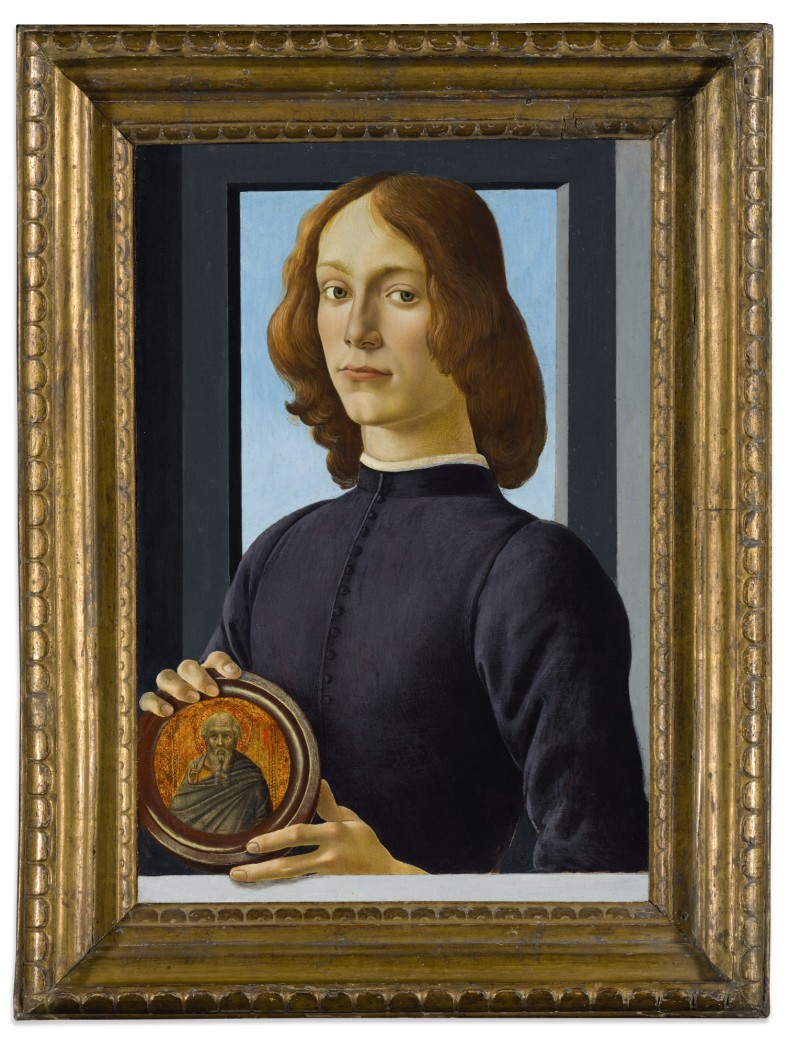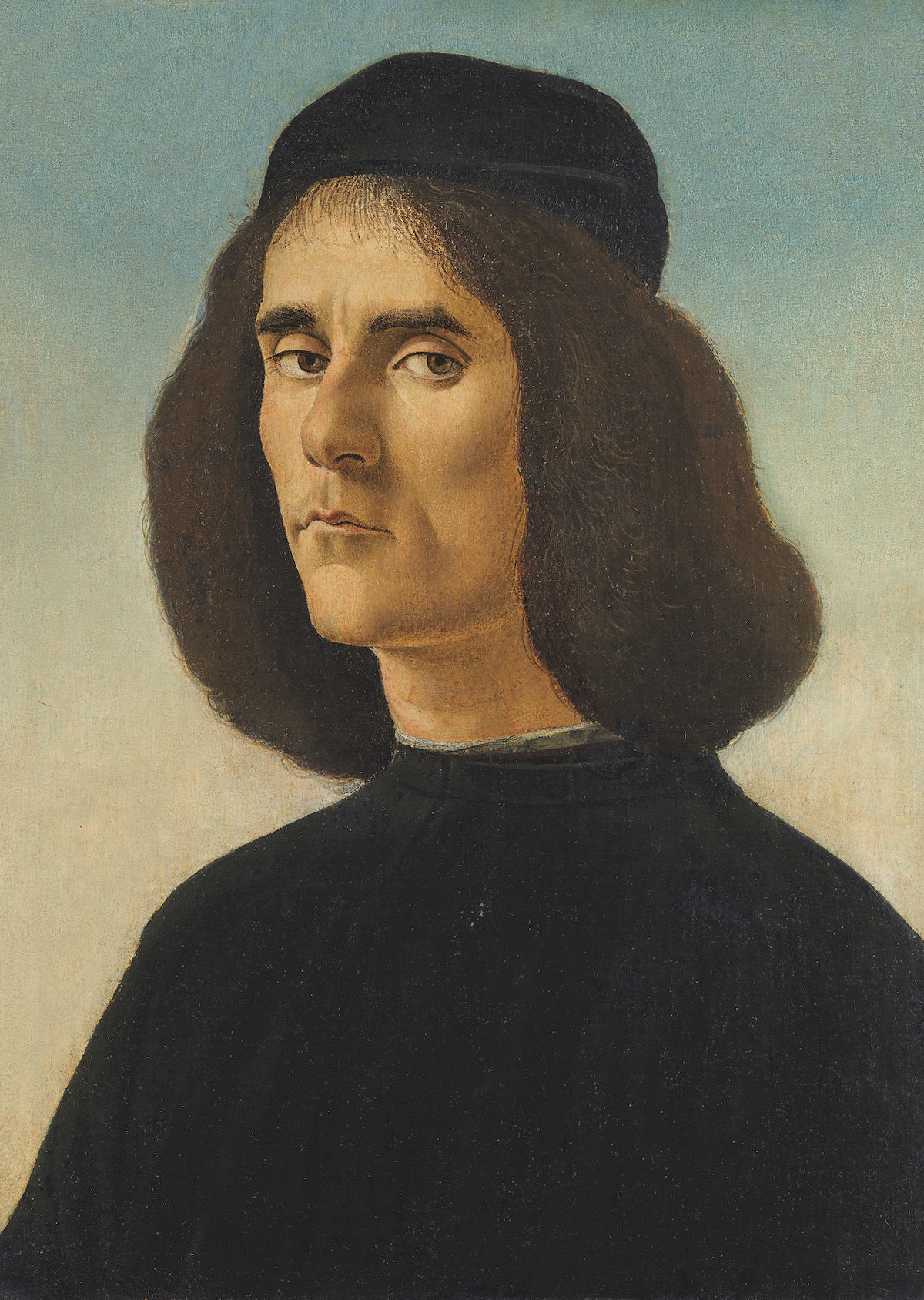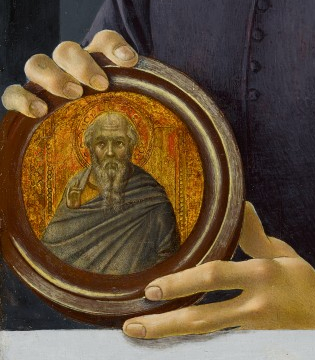Botticelli’s Renaissance ‘golden boy’
[29.01.2021]
Sandro Botticelli, Portrait of a young man holding a roundel
The consignment of a superb Sandro BOTTICELLI (c.1445-1510) painting to Sotheby’s is indeed a master stroke for the auctioneer; not only are paintings by the Renaissance master extremely rare, his portraits are almost impossible to find! The last time a Botticelli appeared on the market was in 2013 with a superb ‘The Rockefeller Madonna’: Madonna and Child with Young Saint John the Baptist which set a new record for the artist at $10.4 million. However, the planets were all in the right place for Portrait of a young man holding a roundel, which is both larger, rarer and in much better condition than the Rockefeller Madonna… and it has just sold for a staggering $92 million.
Unlike its rival Christie’s, which transgressed traditions by including Leonardo da Vinci’s Salvator Mundi (救世主) in a Modern & Contemporary Art sale, Sotheby’s decided to offer the magnificent Botticelli portrait as the highlight of Old Masters Week in New York on 28 January. Estimated at over $80 million, and finally sold for $92 million… the masterpiece has joined the exclusive club of the most expensive portraits ever auctioned, alongside Gustav Klimt’s Portrait of Adele Bloch-Bauer II ($87.9 million in 2006) and Van Gogh’s Portrait of Dr Gachet ($82.5 million in 1990).
The last Botticelli portrait in circulation…
Portrait of a young man holding a roundel was by no means ‘suddenly discovered’; it has a known and prestigious provenance, but one that is discreet. Having remained with the Newborough family in Wales for generations, it was unknown to scholars until it appeared on the art market in the 1930s and was acquired by Frank Sabin around 1935. In 1941 Sabin sold the portrait to British scientist and collector Sir Thomas Ralph Merton and Kenneth Clark, then Director of the National Gallery in London, fully endorsed its attribution to Botticelli. The catalogue of the Merton collection written by Alfred Scharf and published in 1950 therefore mentions the portrait as attributed to Botticelli. Apart from its appearance at the Royal Academy Exhibition in 1960 in London, the painting remained largely out of sight and the majority of 20th century Botticelli specialists failed to mention the work, or attributed it to other painters. Now considered one of Botticelli’s finest and most important works, Young Man Holding a Roundel was purchased by the American billionaire Sheldon Solow at a 1982 Christie’s sale for $1.3 million.
Christopher Apostle, Head of the Old Master Paintings at Sotheby’s New York: “When a genuine masterpiece arrives on the market, it tends to wake people up (…), whatever the period”.

Sandro Botticelli, Michele Marullo Tarcaniota
Before being dubbed Botticelli’s last portrait in private hands, this envious title was held by a portrait of the 15th century Greek-born poet and soldier, Michele Marullo Tarcaniota. Consigned by a family of Spanish collectors, this superb, but far more austere, portrait was offered in October 2019 on Frieze Masters by Trinity Fine Art for $30 million. However, the portrait failed to obtain authorization to leave Spanish territory, so for the time being it has remained unsold and will remain in Spain. This is not the case with the Young Man portrait which is free to move around the world. Sotheby’s and the seller were so confident about its sale that no guarantee was considered necessary.
This latest result illustrates the growing interest in Old Master paintings and indeed the power of Old Master art on the auction market. With most masterpieces no longer in private hands, it has become an incredibly tight and exciting market. High media-profile sales in recent years have led to renewed interest in a hitherto relatively stable segment of the market. As Karl Hermanns (Christie’s Global Head of Old Masters at the time of the Salvator Mundi sale) put it: “In a way, Old Masters have become big name brands in the same way as Contemporary artists like Andy WARHOL or Jeff KOONS”.
A pure masterpiece…
In excellent condition, the tempera-on-panel Portrait of a Young Man Holding a Roundel has a plaster backing to prevent the wood from deforming and measures 58.7 by 39.7 centimeters. The anonymous young man it depicts occupies almost all of the space in a ‘three quarters’ pose and is framed by a grey stone window in the background. His direct gaze plunges towards the spectator. Who can this beautiful teenager be? Like Botticelli’s Portrait of a Young Man with a Medal of Cosimo de’ Medici kept at the Uffizi Museum in Florence – with which it shares many similarities in composition and style – the identity of its model remains unknown. Anonymous yes… but clearly not just anyone!
The majority of Botticelli portraits that have survived to this day depict ‘important’ people, so the subject was almost certainly a close friend of the Medici family. His long blonde hair, his delicate features, his slender fingers… everything about him exudes the Florentine Renaissance, and at the same time the painting is remarkably modern with its highly efficient simplicity, its graphic linearity and its daring colour choices. The window – open to the world – brings the outside world into the picture, and the young man’s hands seem to overlap the frame. In this respect, Botticelli appears to be following the precepts of Leon Battista Alberti who, in his treatise de pictura, states that “painting must bring reality into the imaginary”. The roundel, a focal point of the painting, acts as a painting-within-a-painting and starkly contrasts with its holder. The attractive model is modestly assuming second place behind the object he presents to the public for contemplation: a cockade representing a bearded saint with his right hand raised.
“A giant among portrait painters [Botticelli] can animate the human face, he can apprehend its contours and its planes, he can invest it with a sentient response to the scene when it occurs” (John Pope-Hennessy, 1966)

Sandro Botticelli, Portrait of a young man holding a roundel, detail of the roundel by Bartolomeo Bulgarini, (c. 1300/10 – 1378)
This little painting with its gold background is of course a work of art in itself. The roundel was inserted into a cavity carved into the panel. Although the face, clothing and pose of the saint are strongly inspired by Byzantine models, it is in fact an Italian painting less than a century older than its holder and probably a work by the Sienese painter Bartolomeo di Messer BULGARINI (c.1345-1378), who also worked in Florence. The saint depicted (or the altarpiece from which it comes) may have had a meaning for the painting’s sponsor. The roundel acts as a counterpoint to modernity by highlighting the transition from a traditional religious Trecento painting to a non-religious quattrocento Renaissance portrait where man occupies all the space. The saint is as old as the adolescent is young; his frontal and static depiction contrasts with the dynamic face of the young man with its three-quarters profile. Placed as a sort of trompe-l’oeil between the young man’s fingers and perched on the ledge, the ‘illusion’ is perfect.
The work’s date of creation is estimated between 1470 and 1480. This corresponds to Botticelli’s most prolific period: that of The Birth of Venus (between 1485-1486), Primavera (between 1478-1482) and the decoration of the Sistine Chapel (started in 1480). Indeed, all of Botticelli’s talent and innovative spirit seem to be concentrated in this superb portrait.




 0
0
